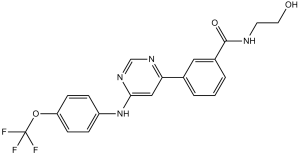GNF-5 (GNF 5; GNF5), a GNF-2 analog with better pharmacokinetic profiles, is a potent, selective and allosteric/non-ATP competitive Bcr-Abl inhibitor with potential anticancer activity. It inhibits Bcr-Abl (wild-type Abl) with an IC50 of 220 nM. It exhibits excellent in vivo anticancer efficacy in Ba/F3.p210 xenograft mouse model.
Physicochemical Properties
| Molecular Formula | C20H17F3N4O3 | |
| Molecular Weight | 418.37 | |
| Exact Mass | 418.125 | |
| CAS # | 778277-15-9 | |
| Related CAS # |
|
|
| PubChem CID | 44129660 | |
| Appearance | White to off-white solid powder | |
| Density | 1.4±0.1 g/cm3 | |
| Boiling Point | 612.4±55.0 °C at 760 mmHg | |
| Flash Point | 324.2±31.5 °C | |
| Vapour Pressure | 0.0±1.9 mmHg at 25°C | |
| Index of Refraction | 1.600 | |
| LogP | 3.31 | |
| Hydrogen Bond Donor Count | 3 | |
| Hydrogen Bond Acceptor Count | 9 | |
| Rotatable Bond Count | 7 | |
| Heavy Atom Count | 30 | |
| Complexity | 544 | |
| Defined Atom Stereocenter Count | 0 | |
| InChi Key | IIQUYGWWHIHOCF-UHFFFAOYSA-N | |
| InChi Code | InChI=1S/C20H17F3N4O3/c21-20(22,23)30-16-6-4-15(5-7-16)27-18-11-17(25-12-26-18)13-2-1-3-14(10-13)19(29)24-8-9-28/h1-7,10-12,28H,8-9H2,(H,24,29)(H,25,26,27) | |
| Chemical Name | N-(2-Hydroxyethyl)-3-[6-[[4-(trifluoromethoxy)phenyl]amino]-4-pyrimidinyl]benzamide | |
| Synonyms |
|
|
| HS Tariff Code | 2934.99.9001 | |
| Storage |
Powder-20°C 3 years 4°C 2 years In solvent -80°C 6 months -20°C 1 month |
|
| Shipping Condition | Room temperature (This product is stable at ambient temperature for a few days during ordinary shipping and time spent in Customs) |
Biological Activity
| ln Vitro | GNF-5 inhibits wild-type Abl with an IC50 of 0.22 µM, but not myristate site mutant E505K (IC50 >10 µM) [1]. |
| ln Vivo | GNF-5 has appropriate pharmacokinetic properties (5 mg/kg IV or 20 mg/kg oral)[1]. GNF-5 is effective in vivo when taken orally, twice daily for seven days at 50 or 100 mg/kg, however relapses are possible[1]. In vivo, nilotinib with T315I Bcr-Abl combo is inhibited by GNF-5 (75 mg/kg, bid)[1]. |
| Cell Assay |
Cell Viability Assay[1] Cell Types: wild type and mutant Bcr- Abl expressing Ba/F3 cells Tested Concentrations: 0.2, 0.8 and 1.6 μM Incubation Duration: 48 h Experimental Results: Inhibited wild-type Abl in a non-ATP competitive fashion. |
| Animal Protocol |
Animal/Disease Models: Male balb/c (Bagg ALBino) mouse[1] Doses: 5 mg/kg, 20 mg/kg Route of Administration: 5 mg/kg intravenously (iv)or 20 mg/kg orally Experimental Results: AUC_inf (min*ug/mL) 292.37 AUC_inf (hrs*nM 11647 Cmax(nM) 4386.08 Tmax(hrs) 0.50 Clast (nM) 636.16 T1 /2(hrs) 2.30 Vss(L/kg) 9.18 F (%) 44.82 Animal/Disease Models: p210 xenograft model[1] Doses: 50 or 100 mg/kg Route of Administration: po (oral gavage) twice (two times) daily, for 7 days Experimental Results: Could normalize blood counts and spleen size. Animal/Disease Models: Bone marrow transduction/transplantation model[1] Doses: 75 mg/kg Route of Administration: twice (two times) daily Experimental Results: demonstrated no significant response (alone). demonstrated no toxicity and had a strong and sustained inhibition of Bcr- Abl-mediated signaling combination with nilotinib. |
| References |
[1]. Targeting Bcr-Abl by combining allosteric with ATP-binding-site inhibitors. Nature. 2010 Jan 28;463(7280):501-6. [2]. Targeting invadopodia-mediated breast cancer metastasis by using ABL kinase inhibitors. Oncotarget. 2018 Apr 24;9(31):22158-22183. |
Solubility Data
| Solubility (In Vitro) |
|
|||
| Solubility (In Vivo) |
Solubility in Formulation 1: ≥ 2.5 mg/mL (5.98 mM) (saturation unknown) in 10% DMSO + 40% PEG300 + 5% Tween80 + 45% Saline (add these co-solvents sequentially from left to right, and one by one), clear solution. For example, if 1 mL of working solution is to be prepared, you can add 100 μL of 25.0 mg/mL clear DMSO stock solution to 400 μL PEG300 and mix evenly; then add 50 μL Tween-80 to the above solution and mix evenly; then add 450 μL normal saline to adjust the volume to 1 mL. Preparation of saline: Dissolve 0.9 g of sodium chloride in 100 mL ddH₂ O to obtain a clear solution. Solubility in Formulation 2: ≥ 2.5 mg/mL (5.98 mM) (saturation unknown) in 10% DMSO + 90% (20% SBE-β-CD in Saline) (add these co-solvents sequentially from left to right, and one by one), clear solution. For example, if 1 mL of working solution is to be prepared, you can add 100 μL of 25.0 mg/mL clear DMSO stock solution to 900 μL of 20% SBE-β-CD physiological saline solution and mix evenly. Preparation of 20% SBE-β-CD in Saline (4°C,1 week): Dissolve 2 g SBE-β-CD in 10 mL saline to obtain a clear solution. Solubility in Formulation 3: ≥ 2.5 mg/mL (5.98 mM) (saturation unknown) in 10% DMSO + 90% Corn Oil (add these co-solvents sequentially from left to right, and one by one), clear solution. For example, if 1 mL of working solution is to be prepared, you can add 100 μL of 25.0 mg/mL clear DMSO stock solution to 900 μL of corn oil and mix evenly. (Please use freshly prepared in vivo formulations for optimal results.) |
| Preparing Stock Solutions | 1 mg | 5 mg | 10 mg | |
| 1 mM | 2.3902 mL | 11.9511 mL | 23.9023 mL | |
| 5 mM | 0.4780 mL | 2.3902 mL | 4.7805 mL | |
| 10 mM | 0.2390 mL | 1.1951 mL | 2.3902 mL |
